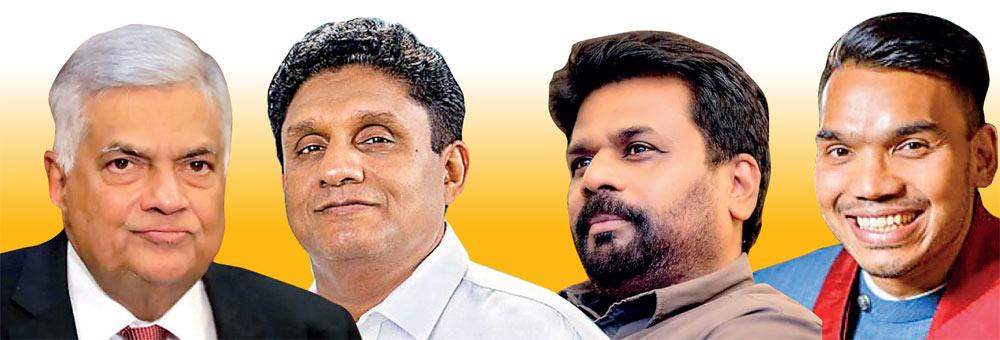Reply To:
Name - Reply Comment

This year’s candidates include President Ranil Wickremesinghe, Opposition Leader Sajith Premadasa (SJB), NPP Leader Anura Kumara Dissanayake and Namal Rajapaksa (SLPP)
 The political landscape continues to evolve rapidly in the lead up to nomination day, and it will be more so when campaigning kicks off. The recent withdrawal of business tycoon Dammika Perera, which prompted Namal Rajapaksa to enter the race unexpectedly, was the latest development that changed political dynamics
The political landscape continues to evolve rapidly in the lead up to nomination day, and it will be more so when campaigning kicks off. The recent withdrawal of business tycoon Dammika Perera, which prompted Namal Rajapaksa to enter the race unexpectedly, was the latest development that changed political dynamics
The upcoming 2024 Presidential election in Sri Lanka is poised to be a unique and unpredictable multi-cornered contest because of the socio-economic and political context in which it is conducted and the presence of half a dozen of high profile candidates.
At previous Presidential races, numerous candidates were present, but it naturally boiled down to a dual between two primary contenders, with the winner securing more than 50 percent of the vote. As such, the winner was declared in the first round itself.
However, people have doubts this time and wonder whether the election will deviate from that norm due to the involvement of several high-profile candidates and widespread disillusionment with traditional political parties.
The key candidates who have already declared their intention to run include President Ranil Wickremesinghe, Opposition Leader Sajith Premadasa who is also the leader of Samagi Jana Balawegaya (SJB), National People’s Power (NPP) leader Anura Kumara Dissanayake, Sri Lanka Podujana Peramuna’s (SLPP) National Organiser Namal Rajapaksa, former Justice Minister Wijeyadasa Rajapakshe, and SJB MP Sarath Fonseka.
The political landscape continues to evolve rapidly in the lead up to nomination day, and it will be more so when campaigning kicks off. The recent withdrawal of business tycoon Dammika Perera, which prompted Namal Rajapaksa to enter the race unexpectedly, was the latest development that changed political dynamics.
This election marks the first since the severe economic crisis that impacted Sri Lankan lives. The crisis led to significant political upheaval, including the resignation of then-President Gotabaya Rajapaksa and the unexpected rise of Ranil Wickremesinghe to the Presidency. The President has since managed to stabilise the economy and restore normalcy. He is now seeking a new mandate based on his performance.
Normally, in any democracy, candidates seek mandates from people to address issues which their societies are grappling with. Political parties always have a set of diehard followers who vote without weighing on merits and demerits. Still, the final outcome will depend on swing voters who take stock of things and decide accordingly. Mindset of such voters will be shaped by a myriad of factors at any election.
The 2024 presidential election is conducted in a different setup. People endured untold sufferings during the economic crisis. However, it opened up avenues for people to understand what the root causes of the problem are.
Against the backdrop, voter priorities in this election will likely centre on economic recovery, governance, and corruption. The economic hardships faced by the populace, including shortages of essential goods, have heightened the electorate’s focus on economic stability.
Additionally, there is a strong public sentiment against corruption and mismanagement which, some voters believe, are rooted in traditional politics.
Campaign themes will centre on what respective candidates can offer to deal with such pressing concerns of the country if elected to office. Voters will decide which candidate is best – suited to address them. Such rational – choice voting will decide on the final outcome of the election rather than party-line voting.
Political dynamics will continue to change further once campaigning begins. Despite the current field of candidates, the contest will eventually narrow to three main contenders.
By the final stages of the campaign, it is likely to become a head-to-head race between two candidates as in any major election in the past. However, predicting the final outcome remains challenging as voter decisions are still in flux.
In fact, some minor and minority political parties are also in flux. For example, All Ceylon Makkal Congress (ACMC) led by MP Rishad Bathiudeen held its deliberations on Tuesday evening but could not agree on any candidate to be supported at the election.
Afterwards, the party leadership decided to consult the rank and file of the party in the North, the East, Mannar and Kurunegala districts. Final decision will be taken by August 14. Besides, the United Republican Front (URF) will also decide on its stand soon after an analysis of current dynamics.
In the north, for the first time, an amalgam of Tamil parties decided to field former Batticaloa district MP of the Tamil National Alliance (TNA) P. Ariyanethran as the common Tamil candidate. However, the dominant Tamil Party, Ilankai Tamil Arachu Katchchi (ITAK) is decided in this regard, and it can impact voter behaviour in the North and the East where Tamils are concentrated. A faction of the party wants to back the Tamil candidate whereas the other groups insist on conditional support to one of the three main candidates. It will also be a decision that can hold sway in this election.
The influence of minor and minority parties adds another layer of uncertainty. Their decisions, particularly in the North and the East, could significantly impact the final outcome. The possibility of a three-way contest evolving into a more traditional two-way race is still on the table, but the current political dynamics suggest that predicting the final result will be more challenging than in previous elections.
As the campaign progresses, further shifts in alliances and voter sentiment can be expected. It will make the 2024 election a closely watched and pivotal event in Sri Lanka’s political history.